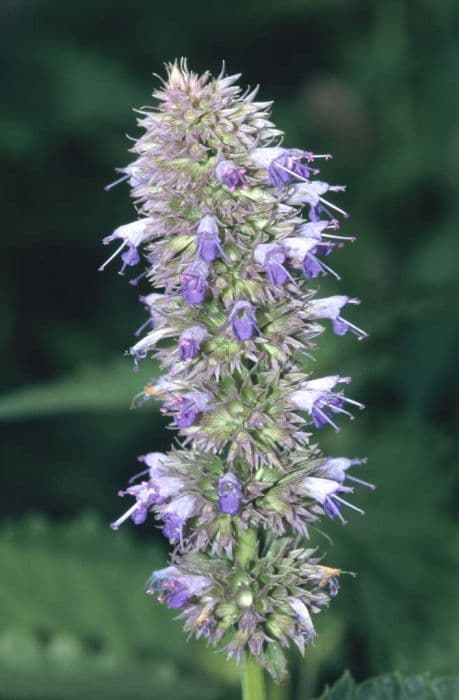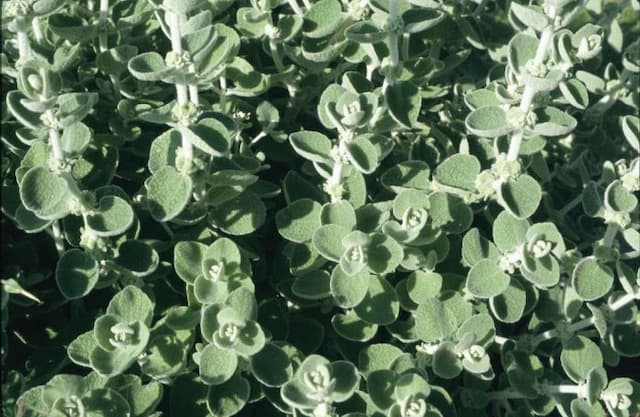Bells of Ireland Moluccella laevis

ABOUT
Moluccella laevis, commonly known as bells of Ireland, displays a distinctive and striking appearance that is widely recognized in floral arrangements for its unique charm. The plant is characterized by its bright green, bell-shaped calyxes that surround small white or pale pink flowers. These calyxes are arranged in whorls around tall, stiff stems, which give the plant an upright and tower-like structure. The lush green of the calyxes impersonates the look of petals due to their prominence and size, while the actual petals are often inconspicuous in comparison. The leaves of bells of Ireland are medium green in color and have a slightly serrated edge, with a lanceolate or elongated ovate shape that tapers to a point. The foliage provides a pleasing contrast to the showy calyxes, though it largely serves as a background to the eye-catching towers of green "bells." The overall appearance of the plant is one of architectural elegance, with a sequential pattern of growth that draws the eye upward, culminating in the visual crescendo of the flower whorls. Bells of Ireland have a clean, geometric beauty, and their color is a lush, vibrant green that stands out in any garden setting or floral composition.
About this plant
 Names
NamesFamily
Lamiaceae.
Synonyms
Bells of Ireland, Shellflower, Shell Flower, Molucca Balm.
Common names
Dracocephalum moldavicum, Moluccella moldavica
 Toxicity
ToxicityTo humans
Bells of Ireland, the common name for Moluccella laevis, is not typically considered toxic to humans. However, handling the plant might cause skin irritation due to the small hairs on its surface for some people. Ingesting any part of Bells of Ireland is not known to cause poisoning in humans, so there are no specific symptoms associated with poisoning from this plant.
To pets
Bells of Ireland, known scientifically as Moluccella laevis, is not generally regarded as toxic to pets. Ingesting this plant is unlikely to result in poisoning, and thus there are no well-documented symptoms of poisoning in pets from Bells of Ireland. However, like with humans, sensitive pets might experience mild irritation or an allergic reaction when coming into contact with its foliage due to the plant's small hairs.
 Characteristics
CharacteristicsLife cycle
Annuals
Foliage type
Deciduous
Color of leaves
Green
Flower color
White
Height
1-3 feet (30-91 cm)
Spread
1 foot (30 cm)
Plant type
Herb
Hardiness zones
2-11
Native area
Western Asia, Middle East
Benefits
 General Benefits
General Benefits- Ornamental Value: Moluccella laevis, commonly known as Bells of Ireland, is prized for its tall spikes of green, bell-shaped calyces that add unique structural interest to gardens and floral arrangements.
- Drought Tolerance: Bells of Ireland can tolerate periods of low water, making it suitable for xeriscaping or in regions where water conservation is necessary.
- Pollinator Attraction: The tiny white flowers within the calyces attract pollinators such as bees, which are essential for the pollination of many other plants.
- Easy to Grow: Bells of Ireland is relatively easy to cultivate from seed and often reseeds itself, providing an ongoing presence in the garden with little effort.
- Cut Flower: The unique appearance and long vase life of Bells of Ireland make them a popular choice for cut flower arrangements, both fresh and dried.
- Companion Planting: As a garden plant, Bells of Ireland can be used in companion planting to help protect and enhance the growth of other plants.
- Seasonal Interest: Providing visual interest from late spring to early fall, Bells of Ireland offer a succession of aesthetic appeal throughout the growing season.
- Landscape Design: The tall and striking form of Bells of Ireland can be used effectively in landscape design to create vertical accents or backdrop plantings.
 Medical Properties
Medical PropertiesThis plant is not used for medical purposes.
 Air-purifying Qualities
Air-purifying QualitiesThis plant is not specifically known for air purifying qualities.
 Other Uses
Other Uses- As natural dye: Bells of Ireland can be used to produce a green dye for coloring fabrics or paper products.
- Craft material: The sturdy stems and distinctive shape make them ideal for use in crafting, such as in dried floral arrangements or wreaths.
- Sound insulation: The dense foliage and structure of Bells of Ireland could potentially be used in creating natural sound barriers in gardens or along roadsides.
- Educational tool: Due to its unusual appearance, it can be used as an educational specimen in botany or gardening classes to illustrate plant structure and diversity.
- Photography: Bells of Ireland are often used as photogenic subjects or backdrops for plant photography, enhancing the composition with their unique shape.
- Garden design: They can be used in garden designs to provide a vertical element or to create a backdrop for lower-growing flowers due to their height and form.
- Holiday decor: Their green color and bell-shaped calyxes make them suitable for festive decoration, particularly for Christmas or St. Patrick's Day themes.
- Insect habitat: The dense foliage provides a habitat for beneficial garden insects, including bees and butterflies.
- Privacy screening: When planted in a dense row, Bells of Ireland can provide a moderate level of visual privacy in gardens or on patios.
- Fragrance enhancement: While not commonly noted for their scent, the leaves of Bells of Ireland may be included in potpourris to add bulk and visual interest.
Interesting Facts
 Feng Shui
Feng ShuiThe plant Bells of Ireland is not used in Feng Shui practice.
 Zodiac Sign Compitability
Zodiac Sign CompitabilityThe plant Bells of Ireland is not used in astrology practice.
 Plant Symbolism
Plant Symbolism- Protection: Moluccella laevis, commonly known as bells-of-Ireland, often symbolizes good luck and protection. The bell-shaped calyxes are believed to bring a guarding element to one's life.
- Good Luck: As the common name suggests, the association with Ireland—a country often associated with luck—gives bells-of-Ireland the symbolic meaning of good fortune and prosperity.
- Prosperity: The vibrant green color of bells-of-Ireland's foliage and calyxes is also a symbol of wealth and abundance, similar to the symbolic meanings of the green color in many cultures.
- Good Wishes: Giving a bouquet containing bells-of-Ireland expresses the sender’s good wishes for the recipient, conveying a desire for their happiness and well-being.
 Water
WaterBells of Ireland prefer consistent moisture but not soggy conditions. During the growing season, water deeply once a week, providing about 1 to 1.5 gallons per plant depending on the weather conditions. In particularly hot or dry periods, you might need to water twice a week. Always check the top inch of soil for dryness before watering. Reduce watering frequency as the plant starts to go dormant in the fall.
 Light
LightBells of Ireland thrive in full sun but can tolerate partial shade. The ideal spot for these plants is one where they receive at least 6 to 8 hours of direct sunlight each day. They can perform well in spots with some light afternoon shade, especially in hotter climates to protect them from excessive heat.
 Temperature
TemperatureBells of Ireland enjoy moderate temperatures and can typically withstand a range from 40°F to 80°F. They can survive minimum temperatures down to 20°F, but for ideal growth, keep them in conditions between 60°F and 70°F. Avoid exposing Bells of Ireland to extreme heat or extended periods of frost.
 Pruning
PruningPrune Bells of Ireland to remove spent flowers and encourage further blooming. The best time for pruning is after a flush of blooms has faded. Regularly deadheading the plants will promote a second round of flowers. Pruning can be done every few weeks during the blooming season to maintain plant health and appearance.
 Cleaning
CleaningAs needed
 Soil
SoilBells of Ireland thrive in well-draining, loamy soil with a pH range of 6.0 to 7.5. To create the ideal soil mix, combine two parts garden soil, one part sand, and one part peat or compost to enhance drainage and provide nutrients.
 Repotting
RepottingBells of Ireland do not typically require frequent repotting. They are often grown as annuals, so repotting is necessary only if you start with a container and then move the plant outdoors as it grows.
 Humidity & Misting
Humidity & MistingBells of Ireland prefer moderate humidity levels but are quite adaptable. They do not require any special humidity considerations when grown in typical garden environments.
 Suitable locations
Suitable locationsIndoor
Place Bells of Ireland near a sunny window and keep soil moderately moist.
Outdoor
Full sun to part shade and well-draining soil for outdoor Bells of Ireland.
Hardiness zone
2-11 USDA
 Life cycle
Life cycleMoluccella laevis, commonly known as Bells of Ireland, begins its life cycle when seeds are sown in the soil, generally in early spring. The seed germinates within a couple of weeks under appropriate temperature and moisture conditions, giving rise to a small seedling. As the seedling grows, it develops a rosette of leaves at the soil surface, followed by a strong central stem. The plant then enters its vegetative stage, where it continues to grow in height and foliage. Following the vegetative phase, the plant starts to produce distinctive spikes covered with tiny flowers surrounded by bright green, bell-shaped calyces, which occur in the flowering stage typically in the summer. After pollination and fertilization, the flowers produce seeds, completing the cycle as the plant senesces, and may self-seed if conditions allow.
 Propogation
PropogationPropogation time
Spring
Propogation: Bells of Ireland, scientifically known as Moluccella laevis, is generally propagated by seeds. To ensure successful germination, it's ideal to start seeds indoors approximately 6 to 8 weeks before the last expected frost date. The most popular method involves spreading the seeds on well-drained soil and pressing them into the surface, as they require light to germinate. It's crucial not to cover the seeds with soil but to maintain consistent moisture by misting them gently. Seeds usually germinate in 14 to 21 days at a temperature of 70 degrees Fahrenheit (approximately 21 degrees Celsius). Once the seedlings have grown and the risk of frost has passed, they can be transplanted into the garden, spacing them about 12 inches (30 centimeters) apart to allow for adequate growth.









